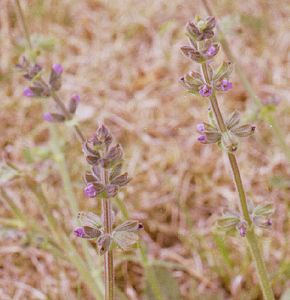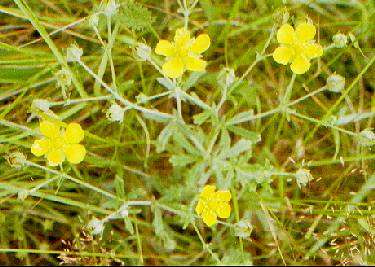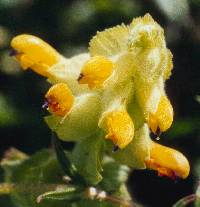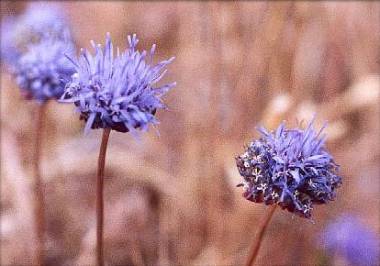In and around Fort Cumberland
Strategically placed at the entrance to Langstone Harbour, the fort is built on a large natural
bank of shingle. There would originally have been plants typical of heath or acidic grassland. The
1838 Parish Tithe map shows the area as pasture, and it would have been much less valuable for farming
than most other parts of Portsea Island.
7.8 hectares of grassland outside the walls of the fort are designated as a Site of
Importance for Nature Conservation (SINC). Some of this land has public access. Skylarks breed
in the area, one of only a few places in the city. Linnets nest in the Gorse bushes, and Dartford
Warblers may spend the winter here. Common Lizards have been found. Grey Bush Cricket, which is
infrequent at a national level, has a strong population here.
Inside Fort Cumberland
 The fort and its earthworks have some interesting natural features, and can be seen occasionally when English Heritage has an Open Day at the Centre for Archaeology.
The fort and its earthworks have some interesting natural features, and can be seen occasionally when English Heritage has an Open Day at the Centre for Archaeology.
Botanically, its claim to fame is Wild Clary, pictured left, which is thought to have come with the stone
from Portland when the fort was built. Much of the grass is close mown, and so the best parts
for butterflies and general variety are the unmanaged parts of the moat. 55 species of flowering
plants have been counted on a casual visit. Nine species of
butterfly, Great Green Bush Cricket and Grey Bush Cricket have been seen. A Little Owl
has nested in the Guardhouse, Tawny Owls have been heard, Barn Owls use an old building, and
Kestrels nest high up on the fortifications.
A small fern, Wall Rue, grows in cracks in the limestone. This plant was once used as a
treatment for rickets because of its calcium content.

Hoary Cinquefoil, pictured right, can be found at only a few places in the
county. It occupies a small patch in a fenced-off field next to Fort Cumberland.
This is not usually accessible to the public. There is also a lot of Gorse here, which will need to be controlled if smaller plants are to persist.
Rifle Range Field
 The area west of the fort has had a varied history in modern times. Formerly the Eastney Rifle
Ranges, it was used in the early 1990s to assemble the pipes for the Long Sea Outfall. This caused
considerable disturbance to the ground. Part of the area, at the end of Melville Road, is now an
"unimproved" car park.
In the field next to the car park are at least two species of Yellow
Rattle, so called because the seed-head rattles when dry. The smaller plants are the common
species, Rhinanthus minor. Larger plants (pictured left) were originally thought to be Greater Yellow
Rattle, Rhinanthus angustifolius, but the latest analysis defines them as Rhinanthus
rumelicus. This species is a native of Europe but new to Britain, and doesn't
have an English name. It was also believed by many that the
Yellow Rattles, and various other plants, were in a seed mixture which was applied after the
pipe assembly work was completed, but the Rev. Ted Pratt, who lived nearby for many years,
says that a seed mixture was not applied, and the area was allowed to regenerate naturally.
The source of the plants therefore remains a mystery. See BSBI News (published by the Botanical
Society of the British Isles), Jan. 2001, p.51 and April 2001, p.65 for more details.
The area west of the fort has had a varied history in modern times. Formerly the Eastney Rifle
Ranges, it was used in the early 1990s to assemble the pipes for the Long Sea Outfall. This caused
considerable disturbance to the ground. Part of the area, at the end of Melville Road, is now an
"unimproved" car park.
In the field next to the car park are at least two species of Yellow
Rattle, so called because the seed-head rattles when dry. The smaller plants are the common
species, Rhinanthus minor. Larger plants (pictured left) were originally thought to be Greater Yellow
Rattle, Rhinanthus angustifolius, but the latest analysis defines them as Rhinanthus
rumelicus. This species is a native of Europe but new to Britain, and doesn't
have an English name. It was also believed by many that the
Yellow Rattles, and various other plants, were in a seed mixture which was applied after the
pipe assembly work was completed, but the Rev. Ted Pratt, who lived nearby for many years,
says that a seed mixture was not applied, and the area was allowed to regenerate naturally.
The source of the plants therefore remains a mystery. See BSBI News (published by the Botanical
Society of the British Isles), Jan. 2001, p.51 and April 2001, p.65 for more details.

Not in doubt here is a fine native blue flower, Sheep's bit. Look for it on tracks
near the junction of Ferry Road and Fort Cumberland Road. It is characteristic of the original
vegetation of the shingle spit that the fort is built on. The plant also occurs nearer the beach
behind the fence around DRA Fraser. Brian Fellows informs me that a single Harebell can be
found on the northern side of Rifle Range Field. Other native plants include Viper's Bugloss, with
tall blue flowers, Kidney Vetch and Bird's Foot Trefoil. Unfortunately, a less welcome arrival
is Japanese Knotweed, which is beginning to form small stands.
Eastney Peninsula
North of Fort Cumberland the shingle spit ends in a point, with the ferry connection to Hayling
Island. There is also the Lifeboat Station, University Labs, sewage pumping station and various
boatyards. It is traditionally a place to leave your dinghy for ever and a day, while some go
one step further and have boats converted into stores and workshops. In amongst all this are just
a few places of wildlife interest. Alongside the road may be found a clover called Toothed Medick Medicago polymorpha. This is its second largest population in Hampshire
after Hurst Castle. In the past Nottingham Catchfly Silene nutans occurred here. There
are good views of Langstone Harbour and its lively narrow entrance, and
the calmer waters of Eastney Lake.
The Friends of Langstone Harbour and the city council have been engaged in the on-going task to rid the area of years of accumulation of boat junk.
Back to Sites
 The fort and its earthworks have some interesting natural features, and can be seen occasionally when English Heritage has an Open Day at the Centre for Archaeology.
The fort and its earthworks have some interesting natural features, and can be seen occasionally when English Heritage has an Open Day at the Centre for Archaeology.

 The area west of the fort has had a varied history in modern times. Formerly the Eastney Rifle
Ranges, it was used in the early 1990s to assemble the pipes for the Long Sea Outfall. This caused
considerable disturbance to the ground. Part of the area, at the end of Melville Road, is now an
"unimproved" car park.
In the field next to the car park are at least two species of Yellow
Rattle, so called because the seed-head rattles when dry. The smaller plants are the common
species, Rhinanthus minor. Larger plants (pictured left) were originally thought to be Greater Yellow
Rattle, Rhinanthus angustifolius, but the latest analysis defines them as Rhinanthus
rumelicus. This species is a native of Europe but new to Britain, and doesn't
have an English name. It was also believed by many that the
Yellow Rattles, and various other plants, were in a seed mixture which was applied after the
pipe assembly work was completed, but the Rev. Ted Pratt, who lived nearby for many years,
says that a seed mixture was not applied, and the area was allowed to regenerate naturally.
The source of the plants therefore remains a mystery. See BSBI News (published by the Botanical
Society of the British Isles), Jan. 2001, p.51 and April 2001, p.65 for more details.
The area west of the fort has had a varied history in modern times. Formerly the Eastney Rifle
Ranges, it was used in the early 1990s to assemble the pipes for the Long Sea Outfall. This caused
considerable disturbance to the ground. Part of the area, at the end of Melville Road, is now an
"unimproved" car park.
In the field next to the car park are at least two species of Yellow
Rattle, so called because the seed-head rattles when dry. The smaller plants are the common
species, Rhinanthus minor. Larger plants (pictured left) were originally thought to be Greater Yellow
Rattle, Rhinanthus angustifolius, but the latest analysis defines them as Rhinanthus
rumelicus. This species is a native of Europe but new to Britain, and doesn't
have an English name. It was also believed by many that the
Yellow Rattles, and various other plants, were in a seed mixture which was applied after the
pipe assembly work was completed, but the Rev. Ted Pratt, who lived nearby for many years,
says that a seed mixture was not applied, and the area was allowed to regenerate naturally.
The source of the plants therefore remains a mystery. See BSBI News (published by the Botanical
Society of the British Isles), Jan. 2001, p.51 and April 2001, p.65 for more details.
